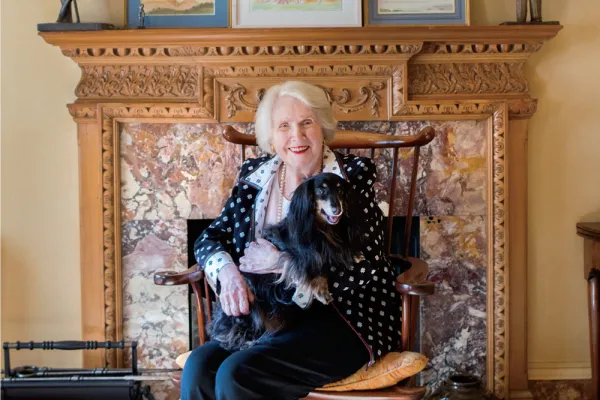Master Collector
Alum News

Published December 5, 2016
On a warm and brilliantly sunny September afternoon, Carol Osuchowski Selle ’54 takes a seat in the parlor of her apartment, located high on Park Avenue in New York City, and admires the light coming through the tall windows. “It’s creating this wonderful golden glow,” she says. Selle is in good spirits.
The night before, she was feted by Smith College President Kathleen McCartney and about 60 fellow alumnae. The occasion was a celebration of her recent announcement of a promised gift to the Smith College Museum of Art of a collection of master drawings from artists including Edgar Degas, Willem DeKooning, and Otto Dix, among others. “It was delightful,” Selle says of the party. “The women were so smart and it was lovely to be in the company of others who appreciate great art.”
The drawings in Selle’s collection, which date from the 19th and 20th centuries, currently adorn the walls of her elegant apartment. In the music room are works by Degas, Raoul Dufy, Henri Matisse, Piet Mondrian, and Alberto Giacometti. Along the hallway hang drawings by Larry Rivers, Richard Artschwagger and James Rosenquist. German art fills the sitting room, dining room and entryway and includes works by Max Beckmann, George Grosz, George Baselitz, and H. R. Penck. Collectively, they tell a rich story not only of specific moments in each artist’s career but also of Selle’s own four-decade-long quest to acquire high-caliber works of art.
Jessica Nicoll ’83, director of the Smith College Museum of Art, calls the collection “one of the most distinguished of its kind” and reflective of Selle’s “connoisseur’s eye and scholarly mind.” “Her gift is so important to the museum because it brings works of extraordinary quality into the collection, amplifying existing holdings of modern French and American drawings, and establishing a whole new area of strength in German art,” Nicoll says.
In honoring Selle, President McCartney said the donation of her collection will “elevate the reputation of the Smith College Museum of Art and make it possible for students to learn not only from studying the master drawings themselves but also from Carol’s own experience as a collector.”
“Her gift is so important to the museum because it brings works of extraordinary quality into the collection and establishes a whole new area of strength in German art.”
It is exactly what Selle hoped for when she decided to leave these master drawings to Smith. “They will have the most impact there,” she says. “Why break up the collection? I want it to benefit students and inspire others to give as well.”
Selle began developing an eye for great art at a young age. Growing up in Chicago, she regularly attended the Art Institute of Chicago, where she’d sit in a large auditorium with dozens of other children and draw for hours. “There would be a model up front and we’d sketch and then they would give out honorable mentions for the best drawings,” she says. “I still have some of those early drawings of mine somewhere.”
She attended the Francis W. Parker School and the Dana Hall School in Wellesley, Massachusetts, for two years. From there, at her mother’s insistence, Selle enrolled at the University of Michigan, despite having been accepted to the Yale School of Architecture. Selle realized quickly, though, that the university wasn’t right for her. “I applied to Smith and that definitely changed the course of everything,” she says.
What drew her to Smith, she says, was a desire to study art with some of the leading scholars of the time: Phyllis Lehmann, Leonard Baskin, and architectural historian Henry Russell Hitchcock, who was also director of the Smith College Museum of Art from 1949 through 1955. “He was a heavyweight,” Selle recalls. “Nobody was teaching what he was teaching at that time.”
It was Baskin, her studio art instructor, who first instilled in her a desire to collect. “He had an impressive collection himself,” she says. “His collecting instinct inspired all of us, I think. In fact, one of the very first pieces I bought while I was at Smith was a Baskin.”
 A career in art education and curating followed Selle’s graduation from Smith, as did a master’s degree in art from the University of Chicago. Her first job was in the education department at the Art Institute of Chicago, where she would lead tours and deliver lectures to hundreds of visitors daily. Later, she organized and helped curate an exhibition of German Realist drawings from the 1920s at the Guggenheim and an exhibition of Matisse drawings and cutouts for the Staatsgalerie Stuttgart in Germany. She also curated a Larry Rivers show in 1970 for the Art Institute of Chicago after he drew her portrait. “I ended up finding all of these drawings in his studio,” Selle says. “I used bread to clean them up so they could be displayed.”
A career in art education and curating followed Selle’s graduation from Smith, as did a master’s degree in art from the University of Chicago. Her first job was in the education department at the Art Institute of Chicago, where she would lead tours and deliver lectures to hundreds of visitors daily. Later, she organized and helped curate an exhibition of German Realist drawings from the 1920s at the Guggenheim and an exhibition of Matisse drawings and cutouts for the Staatsgalerie Stuttgart in Germany. She also curated a Larry Rivers show in 1970 for the Art Institute of Chicago after he drew her portrait. “I ended up finding all of these drawings in his studio,” Selle says. “I used bread to clean them up so they could be displayed.”
What stayed with her was her deep interest in collecting. From the time she bought a tiny Victor Hugo drawing while still a student at Smith, Selle felt the joy that comes from acquiring great works of art and then preserving them for others to enjoy and learn from. She often worked with dealers and other collectors to find pieces she was interested in and used her own extensive knowledge and keen eye to curate her collection.
One thing Selle quickly discovered was the brutal competitiveness and often unfair gamesmanship of the collecting world. Being a woman didn’t make it easier. While working at the Art Institute of Chicago she recalls being asked to give back a Fernand Léger drawing from the 1930s she had purchased so that the curator at the museum could buy it himself. “I thought that was terribly unfair and incredibly poor sportsmanship,” she says.
It dawned on her that if she was going to be a successful collector, she was going to have to play by her own rules. Months later, while waiting outside the Art Institute, she saw a dealer walking toward the building. She stopped him and asked what he had that day. He pulled out a Matisse drawing. “I told him, ‘Say, that’s nice. How much?’” Selle recalls. “He told me, and I whipped out my checkbook, wrote him a check right there and put the drawing under my arm and walked home with it. I knew that if I’d said anything they would have made me give up that drawing.”
Over the years, smarts like that helped Selle amass an enviable collection of master drawings, with a particular emphasis on German art. She can’t pinpoint a reason why she focuses on drawings, but, she says, it might go back to the hours and hours she spent drawing at the Art Institute of Chicago as a child. “It wasn’t until later in life that I realized I was concentrating on the human figure,” she says.
What distinguishes the master drawings she is leaving to Smith is that they are all complete. “They are not sketches, or fragments,” Selle says. “I’ve always preferred drawings that are finished, edge to edge. You see the artist’s full intention when the drawing is complete.”
She hopes the collection will expand student and faculty scholarship, especially in the area of German art, and help elevate the Smith College Museum of Art’s drawing collection to world-renowned status.
“Smith already has an impressive collection, but if other drawing collectors do something and give their art, the museum will become known as the place to go to see exquisite hand drawings.”
As Selle considers her collection’s future at the museum, she has one simple request: “Keep it clean and tidy.”
This story appears in the Winter 2016-17 issue of the Smith Alumnae Quarterly.
Carol Osuchowski Selle ’54 hopes her collection of master drawings inspires scholarship and philanthropy. Photograph by Joshua Paul